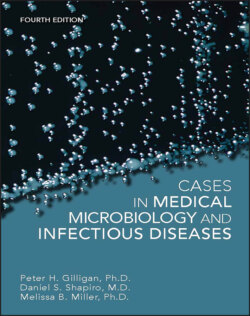Читать книгу Cases in Medical Microbiology and Infectious Diseases - Melissa B. Miller - Страница 50
CASE 6
ОглавлениеA 40-year-old woman presented to her primary care physician for a routine annual health exam. She had no concerns beyond stress related to marital problems. She reported regular menstrual cycles every 4 weeks and a normal Pap history with no record of previous sexually transmitted infections. Her review of systems and pelvic examination were normal. Cervical sampling for a Papanicolaou-stained (Pap) smear was performed. Cytologic examination showed atypical squamous cells of uncertain significance (ASC-US), so the pathologist ordered a human papillomavirus (HPV) molecular detection test, which returned positive. Molecular testing for Chlamydia trachomatis and Neisseria gonorrhoeae was negative.
Due to her HPV-positive ASC-US result, the patient was referred to a gynecologist for evaluation. During this visit she stated she and her husband of 20 years had separated during the last year, and she had a new sexual partner. A colposcopy was performed in which cervical lesions were identified and biopsied. Pathologic examination of the biopsy showed benign endocervical epithelium with acute inflammatory cells, but no squamous epithelium was present for evaluation. Since the biopsy showed no evidence of dysplasia or HPV cytopathic effect, the patient was asked to follow up in 6 to 12 months.
At 6 months, her physical exam was normal with the exception of presumed bacterial vaginosis. A Pap smear was repeated and showed ASC-US, which was HPV positive. A colposcopy was performed, and lesions were biopsied. Pathologic examination of two biopsies showed squamous and endocervical mucosa present with reactive epithelium changes, but no dysplasia or HPV cytopathic effect was identified. Six months later a repeat Pap was normal and HPV testing was negative, so she was told to return in 1 year.
At her next annual exam, a Pap examination showed atypical squamous cells including both low-grade and high-grade squamous intraepithelial lesions (LSIL and HSIL, respectively). She was again HPV positive. Three biopsies were obtained which showed high-grade dysplasia that could not be further characterized due to scant sampling, but was likely CIN 2 or CIN 3 (cervical intraepithelial neoplasia, a cervical cancer precursor). Subsequently, she underwent a loop electrosurgical excision procedure (LEEP) which did not show any remaining dysplasia at the margins.
1 1. What is the most common outcome of HPV infection? In what patient population is HPV most prevalent?
2 2. Describe the range of infectious complications associated with HPV.
3 3. What are the pathologic changes associated with persistent HPV infection of the female genital tract?
4 4. Several molecular tests are available for the detection of HPV DNA. What are the challenges associated with these tests? What are the advantages of molecular tests for HPV?
5 5. What guidelines exist for the monitoring of HPV infection and atypical Pap results? At what intervals should testing take place?
6 6. How can HPV infections be prevented?
